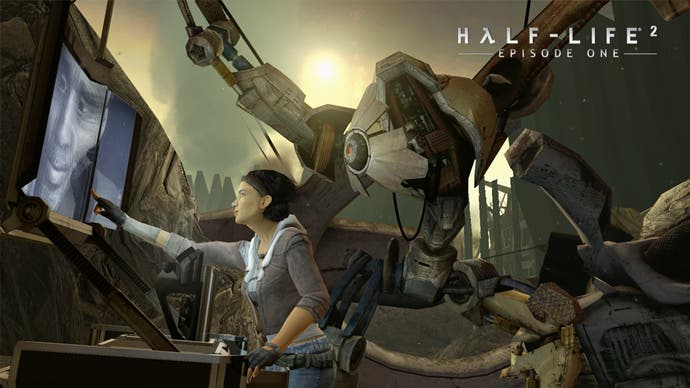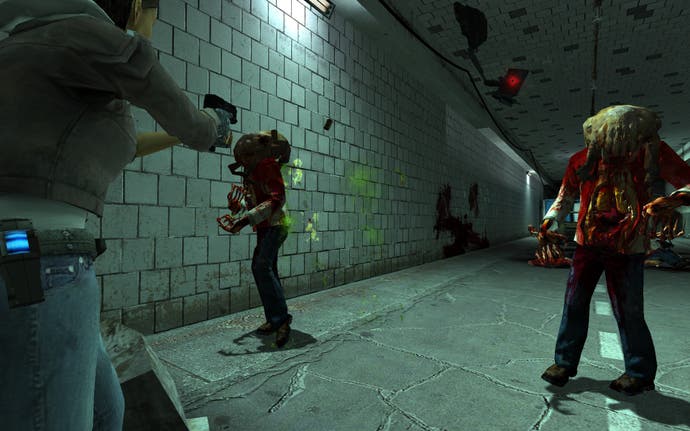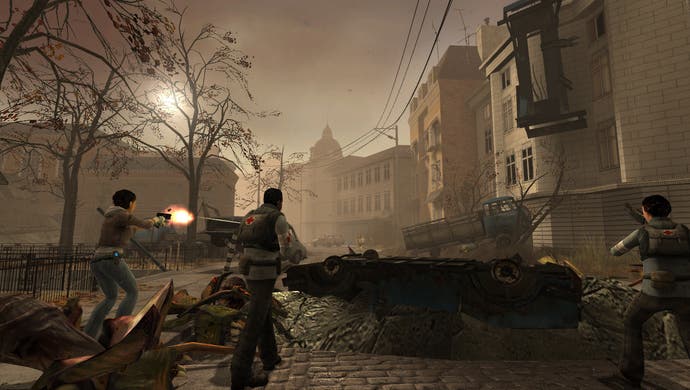GC: Valve opens up in Leipzig
Doug Lombardi on Episode Two, TF2 and Portal.
Half-Life 2: Episode Two and its three-game entourage - on three platforms - has slipped until Q1 2007. February, we're told. But if you ever really expected to play it this year you were probably kidding yourself anyway. Fortunately it's sounding really rather good - the presence of all-new areas in Episode 2 have given Valve the chance to implement numerous technological improvements, including better art assets, lots of new enemies, and a more spectacular use of physics. Speaking to Eurogamer at Leipzig's Game Convention, Valve's Doug Lombardi spoke candidly on release date, price, the background to the re-emergence of Team Fortress 2, and how - if things had been different - the Portal gun might even have wound up in Half-Life 2 in the first place.
Yes that's right.
No, it's just sort of classic Valve being overly aggressive on our dates. But we're aiming for Q1 right now and we're really far along in the playtest stage. You know, our thing is always that we're trying to make really good experiences and so we're going to manage to that rather than the schedule.
Yeah. Our traditional model has been we release on the PC and then somewhere in the next five years or something it'll make it to a console, and we're finding out that there's parity between the PC and the next-gen systems, so we're able to deliver the same great experience on all three platforms. We're working together with EA to extend the initial launch - we're working on the 360 version and the PC version, and we're collaborating with them and some of their studios on the PS3 version - to deliver everything at the same time.

Actually we're working on the price for all three platforms. On all three platforms there'll be on SKU [stock keeping unit] available that's Half-Life 2, Episode One, Portal, Team Fortress 2 and Episode Two. And that will probably end up being around standard full price as a console title and a PC title. And then on the PC there will be a pack that's just Episode Two, Portal and Team Fortress 2, and we're still working out the pricing for that but it'll probably be somewhere in between Episode One [pricing] and full price.
For Episode Two the initial idea was that it was going to be the same size as Episode One but it's sort of meandering to be slightly longer. I don't think that it's going to end up being as big as Half-Life 2 but I think probably it'll end up being a little bit longer than Episode One was.
No, I think some people... You know, we take in feedback on a lot of stuff in terms of the size and the length and we weren't as... We didn't see as much feedback on that as we did people wanting new things to play with, new environments to explore, and new multiplayer stuff, so Episode Two is completely different-looking - you're out in the forest now, you've left City 17, there's new weapons, new creatures and new vehicles to experiment with and play with - and Team Fortress 2 is included on the multiplayer side. And in terms of providing a response to that feedback, that's really where we focused more on in terms of putting value in the pack rather than saying it needs to be an hour longer or 20 minutes longer or what-have-you. Those things tend to sort of happen more organically based on how the experience feels and whether we're telling the right amount of story to set up Episode Three.

It's absolutely a fair comment to say that Episode Two is more advanced technologically and graphically. We've had a bit more time to work on that one. We're on a new location, which allows us to start from scratch on the art assets, because Episode One was still in City 17. So it made more sense this time to leverage a lot of the existing stuff, but we have done a lot more work to the lighting system, the particle system, and Episode Two also contains support for multi-core processing system, so our high end has gone up considerably in terms of where we can scale up to, and of course we're showing absolutely the best stuff at all the trade shows [laughs].
Yeah [laughs].
No, I mean right now the next-gen consoles are pretty close in terms of parity to where the PC is. In terms of horsepower and CPU and on the GPU side. As we move forward obviously those systems are going to be locked down and the technology's going to continue to evolve, but right now there's really a nice sweet spot just being able to deliver a very consistent experience across the different platforms.
I think it's too soon to say which version's going to be the definitive, best version or what-have-you. We develop on the PC and we're PC folks, so obviously we're going to have our preferences as to which one we play, but that's going to be based on input devices just as much as it is graphics, but I think right now in terms of horsepower it's a pretty even race. So I think folks are really going to be able to pick and choose based on their preference for which platform they'd rather play it on - are they mouse/keyboard guys or are they gamepad guys.

Since Atlanta E3 in '99 when we first showed Team Fortress 2 as a very army-looking style game, there's been three iterations of the game that we built and sort of scrapped internally.
The most significant reason for that was the look and feel of the game, and sort of drifting from the look of the original Team Fortress. The gameplay in TF Classic and Team Fortress for Quake was sort of over the top rather than super realistic stuff and when we started to move down the army route all of a sudden it became really serious and quickly we realised we weren't building Team Fortress. And then at the same time Half-Life 2's development started kicking up and the Source Engine was born, and so that team said, "we're kind of headed down the wrong art-style path, and there's this great technology coming online that we want to take advantage of" so it was a natural shift there. And then we went down an interim art style and gameplay approach that varied as well from the roots of Team Fortress.
And we feel that now we've got something that's full of that true, over the top style, encouraging that style of play, but also one of the things we took into consideration was to give each class a visible identity if you will, a readable hierarchy so that if you're in combat you'll be able to tell from great distances whether or not it's a heavy you're about to deal with or a pyro - just from their silhouette - which is something we feel is very important to multiplayer games, and something we've always sort of beat ourselves up about with Counter-Strike and Day of Defeat, where it's a little bit hard to tell people apart at a distance. And in those games perhaps it's not quite as important as it is in TFC, because those character classes are so defined and they're so specific that you're really going to want to tune your approach to those players differently than you would perhaps the different characters in Counter-Strike or other games.
That's one of my favourite games of all time, actually [laughs]. All our decisions are based on decisions by what we call cabals, and folks iterate stuff and will pass it around and evolve it and what-have-you. For us the art style came from many influences, from '60s graphic artists, from plastic spy movies, from some of the Saturday morning cartoons from when we were kids.
Some of those influences are pretty apparent, and it was something for us that really clicked that... when we're playing Team Fortress, and we're in a classic match on dustbowl or what-have-you, you go from those moments of total laughter and craziness to everybody being very tense as you're on that last capture point.
It's a game that can be very humorous and very tense at the same time, and we wanted to find an art style that could match that, where the players had characters that you could have an affinity with - with the sniper with the hat and the glasses and stuff. That's a character people could get into and play that role of, and at the same time it supports the gameplay style of being serious at times and also being very humorous at others.

It supports 32 players, and initially we'll have a collection of maps that are some of the classics such as 2fort as well as some new ones, and in typical Valve fashion, post-release we'll have more.
Absolutely. To us, the Portal gun is similar to the gravity gun in Half-Life 2, and had we been doing episodic back then it would've been great to put out something like Ravenholm as an episode of its own and let people play with the physics and then say, well, now what are we going to do with the physics based on what we saw from people playing with it?
Fast forward to today when we are doing episodic content, we have the Portal game and it's going to be about a three-to-four-hour experience based on the player's skillset, and we'll be able to get a lot of feedback and say, okay, how are we going to use this in Episode Three or in future versions of Half-Life single-player or multiplayer? We'll be able to make more educated decisions about how to progress that sort of technology, which we think really can open the gameplay as much or perhaps more so than the gravity gun and the physics did.
Half-Life 2: Episode Two, featuring Portal and Team Fortress 2, will be out in Q1 2007 - possibly February - on PC, PS3 and Xbox 360.

